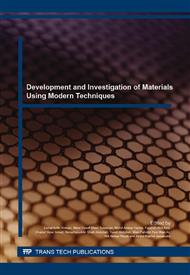p.61
p.66
p.71
p.77
p.82
p.87
p.91
p.97
p.103
Effect of Titania and Magnesia on the Physical Properties of Zirconia Toughened Alumina
Abstract:
ZTA based ceramic composite system is widely accepted as cutting tools for many of these harder and wear resistant workpiece materials. This is due to their beneficial mechanical properties i.e. high temperature strength, high hardness and ability to maintain its cutting edge shape at higher temperatures. Although a lot of works have focused on the effect of various sintering additives on the ZTA ceramic system, the effect of Magnesia (MgO) and Titania (TiO2) on ZTA has not yet been studied. In this work, the physical properties of Zirconia Toughened Alumina (ZTA) ceramic composite with MgO and TiO2 as additives was investigated. The composition of TiO2 varied from 0 wt% to 3.5 wt% whereby other materials such as Al2O3, Yttria Stabilized Zirconia (YSZ) and MgO were kept at constant weight percentage. Sintered samples were then tested and analyzed by XRD, Vickers hardness and high precision densimeter to investigate phase content, hardness value and densification respectively. Results showed that the solubility limit of TiO2 in ZTA-MgO ceramic composites is at 2.0 wt%. Further addition of TiO2 resulted in the formation of secondary phase known as Zirconium titanium oxide (Zr0.35TiO0.65O2) which deteriorate the properties exhibited by ZTA-MgO-TiO2 ceramic composites.
Info:
Periodical:
Pages:
82-86
Citation:
Online since:
January 2016
Keywords:
Price:
Сopyright:
© 2016 Trans Tech Publications Ltd. All Rights Reserved
Share:
Citation:


